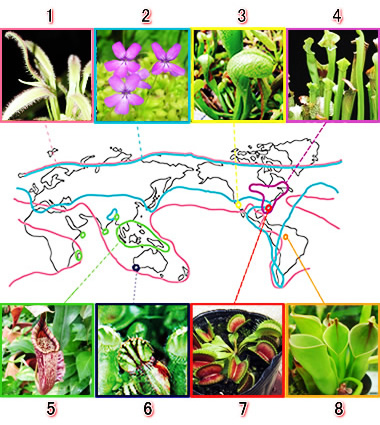Tropical Dream Center
- HOME
- Facilities
- Tropical Dream Center
- Exhibition information
- Insectivorous plant
Insectivorous plant
About the Insectivorous Plant
They are strong plants that capture insects by an ingenious trap and digest them for nutrients. These plants are called “insectivorous plants”.
But why do they capture insects and small animals?
Insectivorous plants mainly grow in humid wildernesses and bogs where plenty of sunlight and moisture can be found. However, since nutrients are scarce in the soil, they capture insects to supplement the nutrients that they tend to lack.
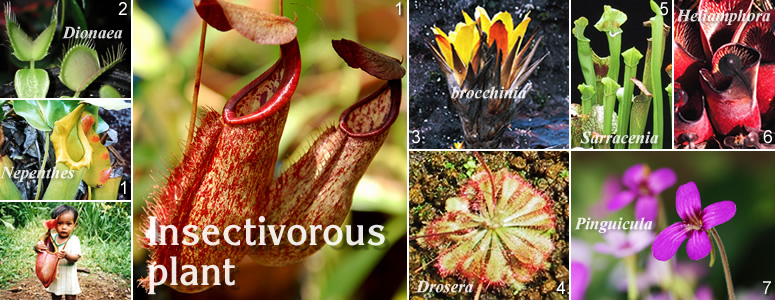
Brocchinia has many leaves rolled in forming a cylinder which becomes yellowish green to stand out in order to attract insects. It captures and digests the insects in water collected inside the leaves.[3]
- Plants of the Genus Nepenthes have a gourd shaped “trap=bag to capture insects”. They attract small animals with “syrup” or “smell” that is emitted from the “bag to capture insects”.[1]
- The Venus flytrap is a plant that closes its leaves to capture and eat insects such as flies and ants.[2]
- Droseraceae plants have leaves with cilia and produce mucilage to capture small insects. Drosera spat hulata naturally grow in Okinawa.[4]
- From the Sarracenia Family. The leaves come in various colors as well as shapes like a cylinder or bag shape. It emits an enticing smell and syrup from its pores which attract the insects to slip down into the bag.[5]
- Heliamphora plants have a similar appearance to Sarracenia but the upper part of the insectivorous leaf opens wider and the lid on top is smaller.[6]
- Bog violet plants, as the name indicates, grows pretty flowers like violets, but it produces sticky mucilage on the surface of the leaf to capture small animals.[7]
How do they capture their preys?
There are mainly three types of known “traps” to capture insects.
Pitfall type
A part of the leaf is shaped like a bag or cylinder which is just like a pitfall. Genera such as Genus Nepenthes, Sarracenia, Darlingtonia, Heliamphora and Cephalotus have this type of structure.
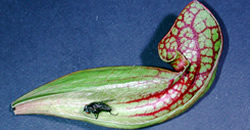
Birdlime type
There are many hairs on the surface of the leaf which produces sticky substance which acts like an adhesive sheet. Genera such as Drosera and Pinguicula have this type of structure.
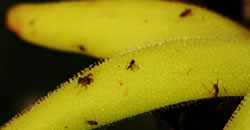
Trap type
Type that senses the movement of insects and reacts by closing its leaves or sucking in the insects like a dropper. Genera such as Dionaea muscipula and Utricularia have this type of structure.
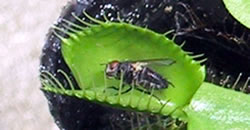
Types of insectivorous plants and their distributions
There are approximately 500 types of insectivorous plants known in the world. Habitats differ depending on the type of plant, and insectivorous plants with various appearances grow in different environments such as hot, cold, and humid, as well as under water.
- Droseraceae plants can be found from cold areas such as the tundra to the bogs of the tropical Asian region and Australia. There are approximately 150 kinds that are known around the world, of which approximately 60 kinds are found in Australia, which is the most in the world.[1]
- Bog violet plants are classified into four broadly divided groups; the alpine belt of Mexico (tropical alpine), the alpines of Japan and Europe (alpines in temperate zones), the flatlands of North America (lowlands in temperate zones), and the alpines of South America (tropical alpines of South America).[2]
- There are only eight kinds of Sarracenia which are can be found from the eastern part of Canada to bogs in the southern part of the United States.[3][4]
- There are approximately 70 kinds of Genus Nepenthes plants known centering in the tropical Asian region surrounding Madagascar, northern Australia, New Caledonia and India.[5]
- The Venus flytrap grows naturally only in the damp plains of North Carolina and South Carolina on the east coast of the U.S. [7]
- Heliamphora plants are representative insectivorous plants of the Guiana Highlands, and there are four kinds that are known. The different kinds grow on separate isolated tepuis or mesas located over 3,280 feet above sea level.[8]
